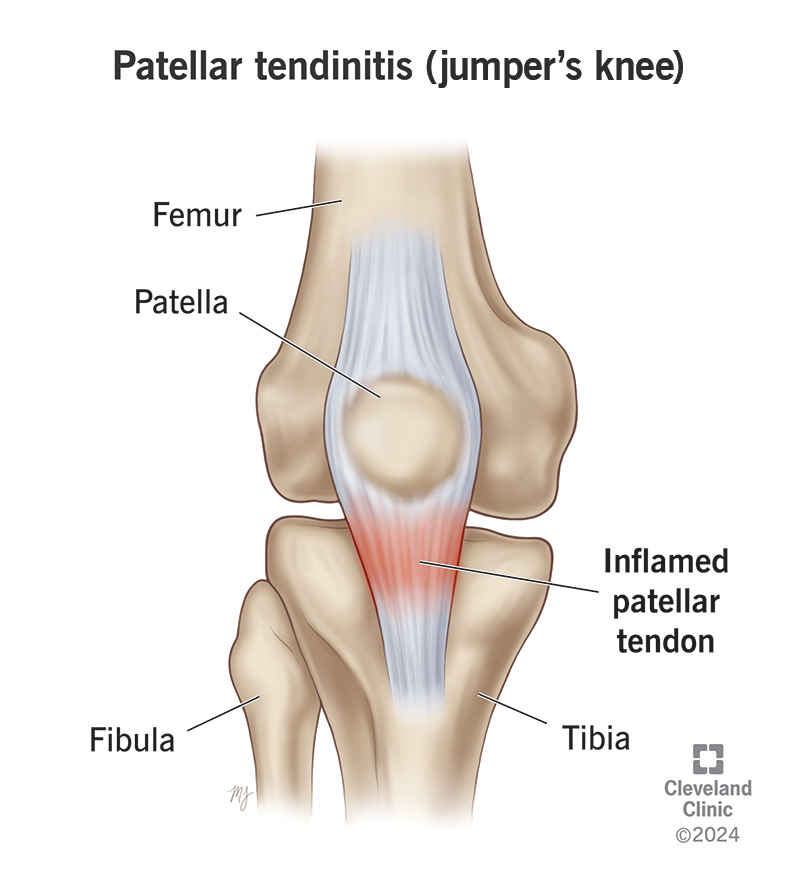Patellar tendinitis happens when repeated movements (like jumping) gradually weaken the patellar tendon in your knee. Symptoms like pain and stiffness can get worse over time, especially if you push through them to keep playing or training. Rest, over-the-counter pain relievers and physical therapy are the most common treatments.
Advertisement
Cleveland Clinic is a non-profit academic medical center. Advertising on our site helps support our mission. We do not endorse non-Cleveland Clinic products or services. Policy

Patellar tendinitis is inflammation in the patellar tendon at the front of your knee.
Advertisement
Cleveland Clinic is a non-profit academic medical center. Advertising on our site helps support our mission. We do not endorse non-Cleveland Clinic products or services. Policy
The patellar tendon connects your kneecap (patella) to the top of your shin bone (tibia). It works with your quad muscle to move your knee and lower leg.
Patellar tendinitis happens when you overuse your patellar tendon. Healthcare providers sometimes call patellar tendinitis jumper’s knee because it’s common among athletes who jump a lot for their sports. Other names for it include patellar tendonitis and patellar tendinopathy. These names all refer to the same condition.
No matter what your provider calls it, you should see them if you have pain in your knee that doesn’t get better on its own with a few days of rest or at-home treatments.
The most common patellar tendinitis symptoms include:
Everyone experiences pain differently, but most people with jumper’s knee feel a low, dull ache at the front of their knees. The pain usually gets worse when you use or move your knee, especially when you straighten it. Certain motions like climbing up or down stairs or squatting are usually painful.
Patellar tendinitis is a repetitive strain injury. Overusing your knee and putting too much repeated stress on your patellar tendon causes it. It’s usually a sports injury, but any repetitive physical activity, job or hobby can cause it.
Advertisement
Repeated wear and tear (like jumping a lot or sprinting often) can make tiny tears in your tendon. If you keep using your knee for intense physical activities, the tears don’t have time to heal. Eventually, this extra stress makes your tendon weak and sore.
The damage that causes patellar tendinitis builds up slowly over time. Two main types of activities can damage your tendon are:
Anyone can experience patellar tendinitis. But some people have a higher risk, including:
Sports that commonly cause patellar tendinitis include:
It’s rare, but untreated patellar tendinitis can increase your risk of a patellar tendon tear (rupture). Continuing to use your knee after you start feeling pain or other symptoms puts even more stress on the small tears and makes you more likely to experience a rupture.
A healthcare provider will diagnose patellar tendinitis with a physical exam. They’ll examine your knee and compare it to your other, uninjured knee. Your provider will ask you when you first noticed symptoms and what you were doing right before they started.
Tell your provider which sports you play, what you do for work or if you do any physical hobbies that you think might have caused the tendinitis. Let them know if any activities or positions make the symptoms better or worse.
Your provider may use imaging tests to take pictures of your knee and the tissue around it, including:
Your provider will suggest treatments to help your patellar tendon heal and manage the symptoms you’re experiencing. The fastest ways to fix patellar tendinitis include:
Advertisement
It’s rare to need surgery for patellar tendinitis. Your provider will usually only suggest surgery if your patellar tendon is torn. They might suggest surgery if you’re experiencing severe symptoms that other, nonsurgical treatments can’t manage.
Advertisement
Yes and no. Yes, rest and giving your body time to heal are important parts of treating patellar tendinitis, and your tendon may heal with time. No, in that patellar tendinitis won’t get better if you don’t change your daily routine.
You need to avoid putting more stress on your tendon and take a break from the activities or sports that caused the tendinitis. Your provider will tell you how long that’ll take based on the symptoms you’re experiencing and the tendinitis’s severity.
Healing takes time. The details of your recovery will depend on which symptoms you’re experiencing and the severity of the tendinitis.
You may start feeling better after resting for a few weeks. But more severe patellar tendinitis may take longer to heal.
Don’t rush your recovery. Pushing your body before it’s fully healed can damage your tendon more, which can set your recovery back.
The best way to prevent patellar tendinitis is to avoid overusing your knees. During sports or other physical activities:
Advertisement
Visit a provider if you experience:
Questions your may want to ask your provider include:
Lots of injuries and health conditions cause knee pain. Some other common knee issues that cause similar symptoms include:
As long as you’re not doing the activities or motions that caused the tendinitis, you should still be able to walk and move normally. Staying active can help relieve and prevent stiffness. Stop and talk to your provider if any movement hurts or makes the symptoms in your knee worse. Ask your provider which activities you should avoid while you recover.
Recovering from patellar tendinitis can be frustrating. You might feel tempted to cut your recovery short. But pushing your body too hard, too soon can make the injury worse.
Be honest with your provider about your expectations. They’ll help you develop a treatment and plan that matches your goals and prioritizes your long-term knee health.
Knee pain can keep you from doing the things you love. Cleveland Clinic experts can craft a treatment plan to get you back to the regular pace of your life.

Last reviewed on 08/27/2024.
Learn more about the Health Library and our editorial process.